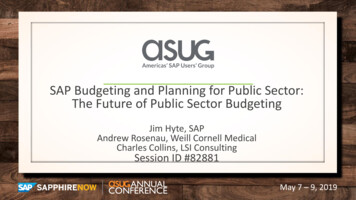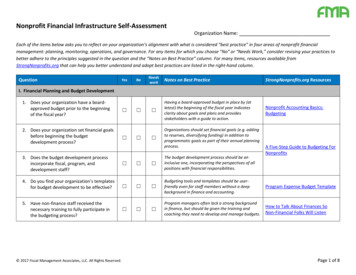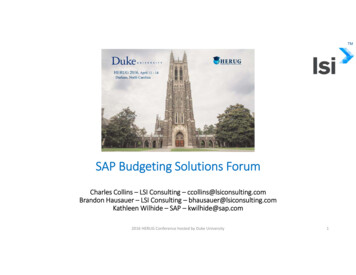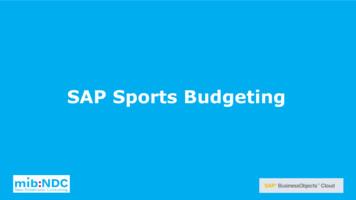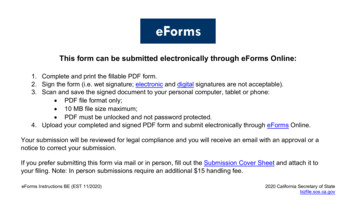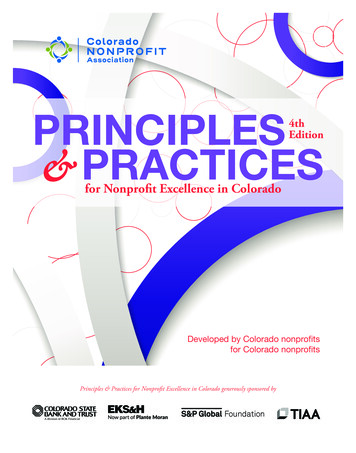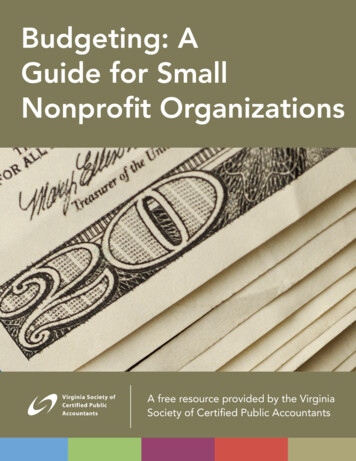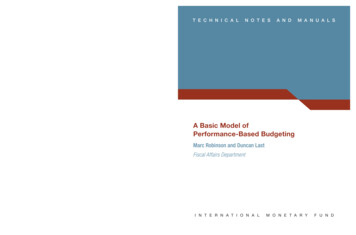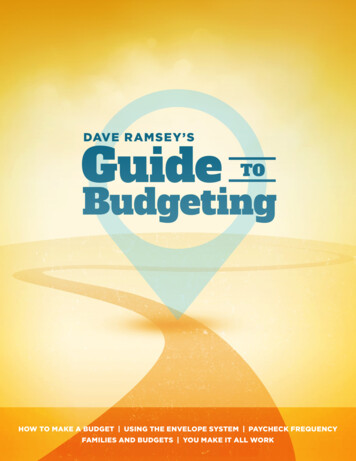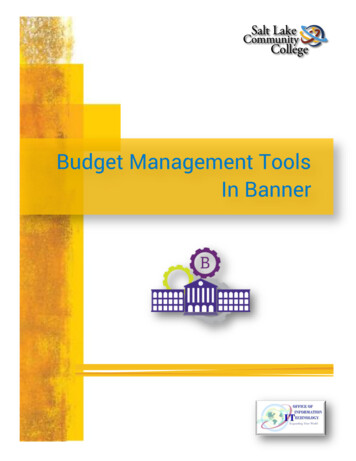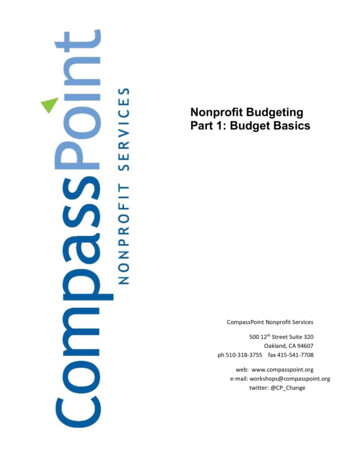
Transcription
Nonprofit BudgetingPart 1: Budget BasicsCompassPoint Nonprofit Services500 12th Street Suite 320Oakland, CA 94607ph 510-318-3755 fax 415-541-7708web: www.compasspoint.orge-mail: workshops@compasspoint.orgtwitter: @CP Changeweb: www.compasspoint.org
DisclaimerAll material is provided without any warranty whatsoever, including, but not limited to, the implied warranties of merchantability or fitness for aparticular purpose. Any names of people or companies listed in this book or in its companion computer files are fictitious unless otherwise noted.Copyright 2017 CompassPoint Nonprofit Services unless otherwise indicated. All rights reserved. This publication, including any companion computer disk, or anycomponent part thereof, may not be reproduced or transmitted in any form or by any means, electronic or mechanical, including photocopying,recording, storage in an information retrieval system, or otherwise, without the prior written permission CompassPoint, 500 12th St, Ste 320, Oakland, CA94607, 415-541-9000 or the author.
Nonprofit Budgeting Part I: Budget BasicsMany of us are initially drawn to work in nonprofits because of a commitment to the causes ourorganizations work toward. At some point we may find ourselves responsible for helping todevelop and manage the financial resources of the organization, with little experience with thetools and language of finance.This workshop is designed for people who are new to budgeting and want to get a baselineunderstanding of the components of a nonprofit budget. We will demystify some of theterminology around budgeting, share examples of different types of budgets and when they areuseful, and practice reading and interpreting both organizational and program-level budget-toactual reports.Learning ObjectivesBy the end of this workshop you will: Understand the components of a budgeting process so that you can begin to develop acustomized step-by-step checklist for your organization or program’s budgeting process; Begin to explore how power dynamics influence budgeting and financial decisionmaking at your organization; Increase your understanding of the terminology and concepts involved in nonprofitbudgeting; Practice reading different budgets and explore what might be the right format for yourorganization or program; Deepen your understanding of your role(s) in the budgeting process and begin toidentify how you can positively influence the process at your organization.1 Page
Nonprofit Budgeting Part I: Budget BasicsThe annual budget is the financial reflection of what a nonprofit business expects to accomplishover a 12-month period. For many nonprofit leaders, budgeting is the most comfortable andinteresting part of financial leadership. Done effectively, the budgeting process actively engagesmany staff and board members who may be uninterested in accounting or monthly financialreporting. It becomes an opportunity for these stakeholders to contribute to the organization’sgoals and priorities. For most organizations, the annual budgeting cycle also offers the best (ifnot the only) time to set meaningful financial goals. The process results in a useful tool—onethat will be used to anticipate problems and to provide a baseline against which actual programand financial experience can be monitored.A Tool for Planning and MonitoringPlanning: The process of building a budget is fundamentally a planning process.In fact, in the course of planning for its future, an organization will oftenregularly revisit its goals, priorities, and activities. This is a healthy andnecessary time of annual reflection and one of the primary reasons thatthe budgeting process should begin several months before year-end.PlanningEven in a relatively straightforward budgeting process where thereseems little doubt about the organization’s overall direction, theact of determining what the organization wants to accomplish,Monitoringhow much that will cost, and how the necessary resources will begenerated is a form of strategic planning—if done thoughtfully.Monitoring: Once adopted, the budget becomes an essential financial management tool helpfulin monitoring ongoing organizational activities throughout the year. With each reporting cycle,the organization compares actual performance against its plan. If the organization has gone “offtrack,” various responses can be considered. If, for example, a program is costing more thananticipated, it may be necessary for management to bring costs down through staff reductions2 Page
or a freeze on non-personnel expenses. Or leadership may decide to revise the plan to take thehigher level of expense into account. Using the budget as an ongoing monitoring tool raisesthese sorts of strategic discussions at the staff and board levels in an ongoing and timelymanner.An Inclusive ProcessIn order for an organizational budget to be accurate, effective, and uniting, the budgetingprocess must be inclusive. While the executive director and key finance staff often play thecoordinating role in the process, all management team and board members have a role to play.Designing an effective process that engages people with multiple perspectives can bechallenging. Program planners and fiscal managers often speak different languages and mayhave different priorities; they may or may not be aware of the importance of each other’sapproach to the budget process. Program planning decisions may be viewed as failing to reflecteconomic realities, while fiscal management decisions are sometimes seen as insensitive to theprogrammatic mission of the organization. These conflicts are often fought out during thebudgeting process—the very process that could unite these viewpoints. The leadershipchallenge is to highlight and integrate these various perspectives the collective goal ofdeveloping a realistic and inspiring plan for the coming year.To be sure, an inclusive process can be a messy one with a great deal of debate and evenfrustration at times. The budgeting process is the ideal time each year to bring anorganizational cross-section into the financial leadership effort. The executive director thatcreates the budget during an all-nighter before the first board meeting of the year—or asks herfinance manager to do so—is almost guaranteeing a less-than-accurate plan and a useless toolfor controlling financial activity throughout the year. People in your organization will feel moreaccountable to a plan that they had some say in developing. In our consulting work withnonprofits, we do not see leaders having much luck holding program and development staffaccountable to budgets they did not contribute to meaningfully.3 Page
7 Stage Budgeting ureEstimatecostsForecastincomeDraftbudgetAdopt andimplementI. Design the processDetermine the roles and decision making processes that will yield the most effectiveinformation gathering, analysis, and decision making to drive the process.Develop a timeline that meaningfully engages multiple perspectives and ensuresapproval prior to the fiscal year end.II. Clarify context and articulate goalsAssess current alignment of organizational values to resource management decisions.Reflect on successes and failures (programmatic and financial) and document learning.Identify opportunities, threats, and emerging trends likely to influence your work (bothprogrammatic and financial); articulate impact on revenue planning and cost structure.Evaluate current financial health by analyzing current year-end forecast, current budgetvariances, and balance sheet strength; articulate impact on capitalization and surplus needs.Name the values, goals, and priorities that should be reflected in this year’s budget.Identify specifically what you need to focus on in this year’s budgeting process, giventhe organization’s values, goals, priorities, and current context (i.e. engaging fundraisingstaff in developing detailed revenue projections rather than setting a target that “fills thegap,” developing a long-term plan for compensation increases with the board financecommittee, etc.).III. Decide on the budget structureArticulate primary purposes of your budget (i.e. funder compliance, monitoringprogress on unsecured funds, testing new cost structure, managing multiple scenarios, etc.)Develop the structure that best supports that purpose (see examples in this manual).Design cost allocation process, if applicable.4 Page
matecostsForecastincomeDraftbudgetAdopt andimplementIV. Estimate costsReview compensation structure and staff time/deployment in context of organizationalvalues, goals, and priorities. Identify compensation/staffing priorities for the coming year.Calculate known/steady expenses for the coming year (including increases in rentalspace, estimates for insurance premiums, planned software purchases, etc.).Conduct deeper research and/or analysis on areas of particular risk (i.e. new/unknowncosts, areas of prior year over- or under-spending).Develop support schedules that substantiate areas of greatest dollar amount and risk(i.e. enrollment expectations, release schedule for restricted funds, detailed fundraisingplans, foundation prospect likelihoods).V. Forecast incomeCalculate known/steady income for the coming year (including secured contracts,multi-year restricted grants, steady fees, baseline contributions).Conduct deeper research and/or analysis on areas of particular risk (i.e. contracts to besecured, new or increased fund development efforts).Develop support schedules that substantiate areas of greatest dollar amount and risk(i.e. enrollment expectations, release schedule for restricted funds, detailed fundraisingplans, foundation prospect likelihoods).5 Page
matecostsForecastincomeDraftbudgetAdopt andimplementVI. Draft budget and document decision pointsDiscuss potential risk areas in income and expense along with analysis of currentcontext and determine level of risk tolerance.Create a consolidated budget spreadsheet, including any potential scenarios and allsupport schedules that were developed during the process.Develop initial draft and verify that it addresses the values, goals, and priorities named.Share draft with staff teams and/or board committees for feedback and refinement.Adjust draft as needed to account for feedback and ensure alignment between namedvalues, goals, and priorities and capacity/funding.Document all assumptions and potential decision points.VII. Adopt and implementPresent budget to the board for approval, focusing discussion on potential decisionpoints and areas of risk to be monitored.Clarify roles and decision making processes to support effective budget monitoring.Design reports for budget-to-actual monitoring, determine timeline for distribution,and process for feedback.Maintain rolling projection that is updated as new information comes in, focused onthe areas of greatest risk or uncertainty.Monitor budget to actual reports regularly and respond to changes as needed.6 Page
EXERCISE: Planning Your Budgeting ProcessDesignprocessArticulateGoalsTaskDesign the ProcessDetermine rolesand decision makingDevelop a timelineDeterminestructurePriority Level123Estimatecosts1 must haveForecastincome2 nice to haveNotesDraftbudgetAdopt andimplement3 maybe laterClarify Context and Articulate GoalsAssess alignment oforganizational valuesReflect on successesand failuresIdentify opportunities,threats, emerging trendsEvaluate organizationalfinancial healthName values, goalsand priorities the budgetshould reflectIdentify primary areas offocus for this year’sprocessDecide on the Budget StructureArticulate your budgetingprocess’ primary purposeDevelop the structure tosupport that purposeDesign cost allocationprocess if neededEstimate CostsReview staff time andcompensation structureCalculate known and/orsteady expensesConduct research andanalysis on areas of riskDevelop supportschedules where neededForecast IncomeCalculate known and/orsteady incomeConduct research andanalysis on areas of riskDevelop supportschedules where needed7 Page
Priority LevelTask123Draft Budget and Document Decision PointsDiscuss potential riskareas and determine levelof risk toleranceCreate consolidatedbudget spreadsheetDevelop initial draft ofbudget; align with values,goals, prioritiesShare draft with staff andboard; collect feedbackAdjust the draft asneededDocument assumptionsand decision pointsAdopt and ImplementPresent budget to boardfor approvalClarify roles and decisionmaking processes forbudget monitoringDesign reports forbudget-to-actualmonitoringMaintain rollingprojectionsMonitor budget-to-actualreports regularlyNOTES:8 Page1 must have2 nice to haveNotes3 maybe later
Power and Decision-MakingA thoughtfully designed budgeting process is an opportunity to explicitly examine how powerand decision-making around money is distributed in the organization, and to potentially disruptoppressive patterns around who holds expertise and decision making authority over thefinancial resources of the organization. One way to start this analysis is through developing apower map and beginning to explore possible shifts. A sample way of power mapping is below.STEPS TO POWER MAPPING:1. Identify all the people who are involved inyour budgeting process (including YOU!).You may also include people beyond thestaff and board of the organization, suchas funders, policy makers, or constituents.Person:2. Name the types of decisions each personor entity holds and what kind of processis used to make these decisions.3. Identify which sources of power1 thisperson or entity draws upon (eitherintentionally or not). Include social powerdynamics such as race, class, gender, etc.4. Draw lines between the circles to indicatewhere relationships exist. Sometimes it’suseful to indicate both formal connections(i.e. supervisory relationships) andinformal relationships (i.e. friendships,close colleagues) using different colors.Decides:Sources of Power:Person:Decides:Sources of Power:Person:5. Discuss your power map as a group –what opportunities exist to distributepower were it is concentrated, open updecision making processes that arecurrently held by a few people, or beginto engage those who have been excludedfrom meaningful involvement?6. Plan for the changes you can implementthis year, including how to support thelearning of those new to the process.Decides:Sources of Power:1 See the “Sources of Power” tool athttp://stproject.org/toolkit tool/sources-of-power/9 Page
Identifying and Expanding Your InfluenceA person who fills a particular position in an organization (e.g. executive director, financemanager, program staff, etc.) may participate in and influence the organization’s budgetingprocess in several ways. Clarifying roles and decision making power is critical in an inclusiveprocess. When positional leaders invite and encourage participation in the budgeting process,there are many ways that people can influence the process without positional authority. Oneway to reflect on the potential of your role in the process is considering your Circle of Concernand Circle of Influence2.CIRCLE OF CONCERN encompassesthe wide range of concerns we mayhave about an initiative or process.CIRCLE OF INFLUENCEencompasses those concerns thatwe can do something about oractions we can take that may affectchange in the areas we care about.2Adapted from The Seven Habits of Highly Effective People by Stephen R. Covey, Simon & Schuster, 1992.10 P a g e
EXERCISE: Identifying and Expanding Your InfluenceAs we start to explore the content today, take a few minutes to write down some of theconcerns you have about your organization’s budget process and/or your role in it so far. Thereare no right answers here – think about why you decided to take this workshop. Then, in theinner circle, begin to identify some pathways to action that you may be able to use to addresssome of these concerns. We’ll revisit this at the end of the day to see what you might add.CIRCLE OF CONCERNCIRCLE OF INFLUENCE What barriers are you facingwhen engaging with yourorganization’s budget process? What regular challenges occur? How well aligned is yourbudgeting process with yourorganizational values? Who might be able to supportyou exploring this concern? What knowledge or experiencemight you contribute? Where are there opportunitiesfor your input to be heard? What skills can you acquire?I have never managed aprogram budget and amnot sure what is beingasked of meThis circle includes examples tohelp spark your thinking.There is a blank set of circleson the next page where you canpopulate your own thinking. Clarify expectationswith my supervisor Seek outside resources(workshops, reading)to help me learn more Ask for a regular meetingwith the finance manageruntil I am comfortable withthe process Discussthe possibilityof simplifying theallocation systemwith the finance director Engage the expertise on ourboard finance committee toexplore some of the largerquestions Meet with one of our keyfunders to present this situationand negotiate a differentstructure to our contract Organize with other similargroups in SF to sparkadditional city supportWe spend so much timeon tedious cost allocationprocesses that there is notenough time to analyze andexplore the bigger issuesfacing our business modelOur mission is focused oneradicating poverty but ouremployees can barely afford basicliving expenses in SF due to ourcurrent wage structure11 P a g e
EXERCISE: Identifying and Expanding Your InfluenceCIRCLE OF CONCERNCIRCLE OF INFLUENCEReflection questions:1. What support do I need to begin to address the concerns I have influence over?2. What work do I want to start or stop doing in relation to our budgeting process andwhat might be a pathway to support that shift?12 P a g e
Basic BudgetDomestic Violence Intervention & Prevention Agency2016-17 Organizational BudgetAs of June 5, 2016Budget2016-17ContributionsFundraising events - netFoundation grantsTotal support80,000135,000125,000340,000Government contractsInterest and dividendsTotal earned revenue815,00910,000825,009Net assets released from restrictionTotal income450,0001,615,009SalariesPayroll taxesEmployee benefitsTrainingPersonnel ank chargesBuilding expensesClients, direct assistance toConferences and meetingDepreciationDues and subscriptionsEquipment rental/maint.InsuranceInterestOther professional feesPostage and deliveryPrinting and el 042,500618,013Total expensesChange in net assets1,586,61128,39813 P a g e
Time-Based BudgetDomestic Violence Intervention & Prevention Agency2016-17 Final Budget for Finance CommitteeAs of June 5, 2016YEProjection2015-16Budget2016-17 Increase/Decrease% Increase/(Decrease)ContributionsFundraising events - netFoundation grantsTotal overnment contractsInterest and dividendsTotal earned 15,00950,000227,45013%16%SalariesPayroll taxesEmployee benefitsTrainingPersonnel %8%75%3%AccountingBank chargesBuilding expensesClients, direct assistance toConferences and meetingDepreciationDues and subscriptionsEquipment rental/maint.InsuranceInterestOther professional feesPostage and deliveryPrinting and el 3,9201,586,611192,69114%(6,361)28,39834,759Net assets released from restrictionTotal incomeTotal expensesChange in net assets14 P a g e
SMALL GROUPS: Time-Based Budget ReviewAt your tables, review the budget on Page 12 and consider the following questions: What do you learn about this organization, given this budget structure? What questions come up for you when reviewing this budget? What does this structure suggest about decision-making?NOTES:15 P a g e
Source-Based BudgetDomestic Violence Intervention & Prevention Agency2016-17 Final Budget for Finance CommitteeAs of June 5, 2016Total2016-17AllenFoundationDept aising events - netFoundation grantsTotal support80,000135,000125,000340,000--Government contractsInterest and dividendsTotal earned revenue815,00910,000825,009--Net assets released from restrictionTotal 815,009SalariesPayroll taxesEmployee benefitsTrainingPersonnel 6431,27932,7352,000387,778AccountingBank chargesBuilding expensesClients, direct assistance toConferences and meetingDepreciationDues and subscriptionsEquipment 0038,8973,6503,20029,00016 P a g 09815,00915,000250,00070015,0001,0001,60012,500All 0016,500
InterestOther professional feesPostage and deliveryPrinting and el 2,500618,013Total expenses1,586,611Indirect allocation, based on funder guidelinesChange in net 18SMALL GROUPS: Source-Based Budget Review At your tables, review this budget and consider the following questions: What do you learn about this organization, given this budget structure? What questions come up for you when reviewing this budget? What does this structure suggest about decision-making?17 P a g e
Activity-Based BudgetDomestic Violence Intervention & Prevention Agency2016-17 Final Budget for Finance CommitteeAs of June 5, 2016Program sFundraising events - netFoundation grantsTotal support-Supporting ActivitiesAdminFundistrationraising80,000- 135,000- 125,000- 125,000340,000Government contractsInterest and dividendsTotal 25,009Released from restrictionTotal 0001,615,009SalariesPayroll taxesEmployee benefitsTrainingPersonnel 00968,598AccountingBank chargesBuilding expensesClients, direct assistance toConferences and meetingDepreciationDues and subscriptionsEquipment rental/maint.InsuranceInterestOther professional feesPostage and deliveryPrinting and el 6,00051,50036,00020,25042,500618,013Total specific costsAllocation of common costsAllocation of admin costsTotal nge in net assets(97,206)(2,768)10,000118,371-28,39818 P a g e
SMALL GROUPS: Activity-Based Budget ReviewAt your tables, review the budget on Page 19 and consider the following questions: What do you learn about this organization, given this budget structure? What questions come up for you when reviewing this budget? What does this structure suggest about decision-making?NOTES:19 P a g e
Basis for Common Cost AllocationIn activity-based budgeting, you must design a reasonable method for distributing an organization’s common or shared costs. Oneway that many organizations do this is based on how much staff time is spent in each activity area (known as an FTE basis). Below isan example of a staffing plan that represents how staff time is expected to be distributed in the coming year. This plan serves assupport documentation for the cost allocation percentages used in the sample budget on page 20.Staffing PlanAs of April 22, naDennisPositionExecutive DirectorDirector of Finance and Admin.Accounting ManagerIT ManagerOffice ManagerCustodianDirector of ProgramsShelter ManagerDay CoordinatorNight CoordinatorIntake CoordinatorCase WorkerCounselorAdvocacy ManagerAdult Community OrganizerYouth Community OrganizerLegislative AdvocateDirector of DevelopmentDevelopment AssociateFTE's without common% of FTE's for allocation of shared20 P a g eTotal 001.001.001.001.001.001.000.7517.00
Basis for Admin Cost AllocationSometimes organizations will also allocate its administrative expenses across the different activities to help identify the “full costs”of each program area and ensure that its fundraising for programs covers a portion of the administrative expenses of theorganization as well as the direct program costs. Often this is done on a direct expense basis, which is calculated below.As of May 29, mmonCostsBudget2016-17Personnel expensesNon-personnel expensesTotal specific 3403,274968,598843,0131,811,611% of FTE'sAllocation of common costsExpenses before admin ,576251,090-1,811,611% of direct costsAllocation of admin costsTotal expensesCalculation for administrative allocations (direct expense basis)Example for Shelter Services:Total Activity ExpensesTotal Expenses – Admin Expenses % of direct costs 928,075 1,811,611 – 189,825 57%21 P a g e
Impact-Based BudgetDomestic Violence Intervention & Prevention Agency2016-17 Final Budget for Finance CommitteeAs of June 5, 2016Core WorkNew Costs/Change CapitalPass-ThroughTotal 2016-17ContributionsFundraising events - netFoundation grantsTotal 00135,000125,000340,000Government contractsInterest and dividendsTotal earned ,0001,615,009SalariesPayroll taxesEmployee benefitsTrainingPersonnel nk chargesBuilding expensesClients, direct assistance toConferences and meetingDepreciationDues and subscriptionsEquipment rental/maint.InsuranceInterestOther professional feesPostage and deliveryPrinting and el 61,19233,419292,0001,586,61126,8171,581-28,398Net assets released from restrictionTotal incomeTotal expensesChange in net assets22 P a g e
Implications for decision makingSUMMARY: TYPES OF BUDGETSType of budgetPrimary purposeAdvantagesDrawbacksTime-based budget:Presents annual budget incomparison to prior yearactuals, and sometimes also tofuture years’ projections. Highlights trends and theTo highlight trends and/ormost dynamic areas ofexpected changes in thechange in the budget fororganization’s financial model.discussion.Boards of directors often findthis view useful for providingcontext when reviewing abudget and it can aid in afocus on longer-term businessmodel shifts. Aggregate data is high-leveland does not provide a wayto look at the variousfinancial drivers at theprogram or project level.Source-based budget:Presents annual budget basedon its funding source reportingrequirements rather than itsactivities. Smooth integration withTo plan for effective costsource-based accounting forrecovery and funderfunding-based budget-tocompliance, primarily used byactual reporting.organizations with a significantnumber of funding sourcesthat require detailed line-item Easy to
Nonprofit Budgeting Part 1: Budget Basics CompassPoint Nonprofit Services 500 12th Street Suite 320 Oakland, CA 94607 p
